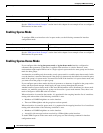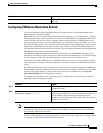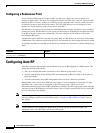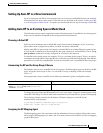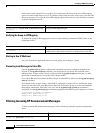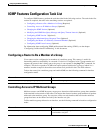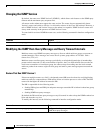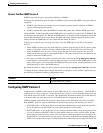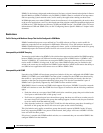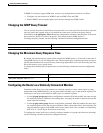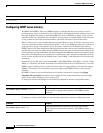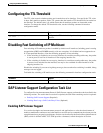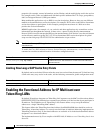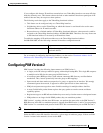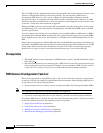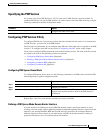
Configuring IP Multicast Routing
IGMP Features Configuration Task List
IPC-412
Cisco IOS IP Configuration Guide
IGMPv3 is the industry-designated standard protocol for hosts to signal channel subscriptions in Source
Specific Multicast (SSM). For SSM to rely on IGMPv3, IGMPv3 must be available in last hop routers
and host operating system network stacks, and be used by the applications running on those hosts.
In SSM deployment cases where IGMPv3 cannot be used because it is not supported by the receiver host
or the receiver applications, two Cisco-developed transition solutions enable the immediate deployment
of SSM services: URL Rendezvous Directory (URD) and IGMP Version 3 lite (IGMP v3lite). For more
information on URD and IGMP v3lite, see the “Configuring Source Specific Multicast” chapter in this
document.
Restrictions
Traffic Filtering with Multicast Groups That Are Not Configured in SSM Mode
IGMPv3 membership reports are not utilized by Cisco IOS software to filter or restrict traffic for
multicast groups that are not configured in SSM mode. Effectively, Cisco IOS software interprets all
IGMPv3 membership reports for groups configured in dense, sparse, or bidirectional mode to be group
membership reports and forwards traffic from all active sources onto the network.
Interoperability with IGMP Snooping
You must be careful when using IGMPv3 with switches that support and are enabled for IGMP snooping,
because IGMPv3 messages are different from the messages used in IGMP Version 1 (IGMPv1) and
Version 2 (IGMPv2). If a switch does not recognize IGMPv3 messages, then hosts will not correctly
receive traffic if IGMPv3 is being used. In this case, either IGMP snooping may be disabled on the
switch or the router may be configured for IGMPv2 on the interface (which would remove the ability to
use SSM for host applications that cannot resort to URD or IGMP v3lite).
Interoperability with CGMP
Networks using CGMP will have better group leave behavior if they are configured with IGMPv2 than
IGMPv3. If CGMP is used with IGMPv2 and the switch is enabled for the CGMP leave functionality,
then traffic to a port joined to a multicast group will be removed from the port shortly after the last
member on that port has dropped membership to that group. This fast-leave mechanism is part of
IGMPv2 and is specifically supported by the CGMP fast-leave enabled switch.
With IGMPv3, there is currently no CGMP switch support of fast leave. If IGMPv3 is used in a network,
CGMP will continue to work, but CGMP fast-leave support is ineffective and the following conditions
apply:
• Each time a host on a new port of the CGMP switch joins a multicast group, that port is added to the
list of ports to which the traffic of this group is sent.
• If all hosts on a particular port leave the multicast group, but there are still hosts on other ports (in
the same virtual LAN) joined to the group, then nothing happens. In other words, the port continues
to receive traffic from that multicast group.
• Only when the last host in a virtual LAN (VLAN) has left the multicast group does forwarding of
the traffic of this group into the VLAN revert to no ports on the switch forwarding.
This join behavior only applies to multicast groups that actually operate in IGMPv3 mode. If legacy
hosts only supporting IGMPv2 are present in the network, then groups will revert to IGMPv2 and fast
leave will work for these groups.
If fast leave is needed with CGMP-enabled switches, we recommend that you not enable IGMPv3 but
configure IGMPv2 on that interface.



